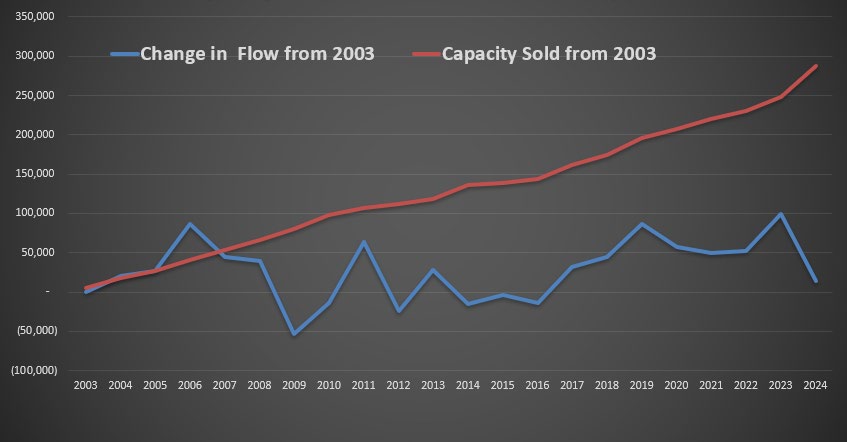Introduction
The utilities sector is a foundational element of Williston's infrastructure, providing essential services that support daily life, enhance public health, and drive economic growth. These services, which include the provision of water, wastewater disposal, solid waste disposal and diversion, electricity, broadband, and others, are not only necessary for the functioning of households and businesses but also for fostering sustainability, resilience, and a high quality of life. As the town continues to grow and evolve, it becomes increasingly important to ensure that utility systems are not only reliable but also efficient, affordable, and environmentally responsible.
This chapter will delve into the various utility systems that serve the town, examining their current conditions, existing challenges, and forecasting future needs. It will also discuss these utilities' role in supporting the town's goals for livability, resilience and equity. The strategies outlined here will offer a roadmap for addressing future challenges, adopting innovative solutions, and building a resilient utility network capable of supporting the town for years to come.
Sewer Capacity is Limited but Can Support the Achievement of Many Long-Range Goals

Figure 1: Sewer capacity sales and actual sewer flows, 2003-2024.
Williston provides sewerage in the service area shown on Map 5. The town's sewer service area is an expression of the town's land use plan to minimize sprawl and concentrate growth within its designated growth center. There are some additional areas currently served by municipal sewer service and these are also identified on Map 8. Properties in these locations were allowed to connect to the town's system either under the Pollution Abatement Provision of the town's Sewer Service Ordinance, or they pre-date the town's current policy.
Sewer capacity is the most limited utility needed to support new development in Williston. The remaining capacity can support the achievement of many long-range goals, but the town will have to carefully prioritize the allocation of remaining capacity in a way that maximizes public benefits.
The sewer collection system was initially constructed in the early 1980's and has expanded within the sewer service area as new development has occurred. The Town owns and operates ten (10) wastewater pump stations, and there are several smaller pump stations that are privately owned and operated. Some of these private pump stations are operated and maintained through the Cooperative Maintenance Agreement administered by the Town.
All of the wastewater collected in the sewer service area is transported north to the River Cove pump station and is pumped in a 10" force main under the Winooski River to the Essex Jct. wastewater treatment facility. Sewage treatment is provided through a Tri-Town agreement with the Essex Treatment Plant. The treatment facility has a capacity of 3,300,000 gpd of which the Town of Williston currently owns a total of 1,040,000 gpd (31.52%). The remaining capacity is owned by the Village of Essex Junction (35.15%) and the Town of Essex (33.33%).1Aldrich & Elliot, Water Resource Engineers. Town of Williston, Vermont Sewer Capacity Analysis. October 2017.
Matt Boulanger, Town of Williston Planning and Zoning. Memorandum Re: Wastewater Allocation Ordinance Attachment A Amendment, March 5, 2025.
Matt Boulanger, Town of Williston Planning and Zoning. Memorandum Re: Wastewater Allocation Ordinance Attachment A Amendment. March 19, 2024.
Universal Broadband Infrastructure is Fundamental to Ensuring Equitable Access to Other Critical Services
Broadband is essential for supporting economic and educational opportunities, strengthening health and public safety networks, and reinforcing freedom of expression and democratic, social, and civic engagement. Vermonters who cannot access broadband face challenges with respect to distance learning; remote working; accessing telehealth services; and accessing government programs and services. Robust and resilient broadband networks are critical to our economic future as a whole and provide a foundation for our educational, health care, public health and safety, and democratic institutions.
Existing providers are not providing adequate service to many rural areas, including some locations in Williston, where fewer potential customers reduce the profitability necessary to justify network expansion. Accordingly, reaching the last mile will require a grassroots approach founded on input and support from local communities.
Act 71 established the Vermont Community Broadband Fund to support policies and programs designed to accelerate community efforts that advance the State's goal of achieving universal access to reliable, high-quality, affordable, fixed broadband, and established the Vermont Community Broadband Board to coordinate, support, and accelerate the development and implementation of universal community broadband solutions. Act 71 enabled the formation of Vermont Communications Union Districts (CUDs), to further coordinate and facilitate these efforts.4Act 71 as Enacted. Accessed 12/27/24 at https://legislature.vermont.gov/Documents/2022/Docs/ACTS/ACT071/ACT071%20As%20Enacted.pdf.
What Is a Communications Union District (CUD)? Chittenden County Regional Planning Commission. Accessed on 4/3/2025 at https://www.ccrpcvt.org/our-work/broadband/.
Email communication with Michael Vance, Chair, Chittenden County Communications Union District. December 30, 2024.
Email communication with Ann Janda, Energy Project Manager, Chittenden County Regional Planning Commission. December 30, 2024.
CUD Agendas and Minutes. Chittenden County Regional Planning Commission. Accessed on 4/3/2025 at https://www.ccrpcvt.org/our-work/broadband/.
Email communication with Michael Vance, Chair, Chittenden County Communications Union District. December 30, 2024.
Town of Williston Selectboard July 2, 2024 Meeting Minutes. Accessed on 4/3/2025 at https://www.town.williston.vt.us/index.asp?Type=B_BASIC&SEC={BF873E20-7A5D-432F-9028-9939B81C0A9B}&DE={0BB0EFBD-8B91-43F1-813E-2C4EEBF98010}.
Other Utilities (Water, Solid Waste, Gas, Electricity) are Largely Controlled by Other Entities
Water is provided regionally through the Champlain Water District and distributed by the Williston Public Works Department. CWD is a nationally award-winning provider of water, sourced from the deep underwater canyon of Shelburne Bay in Lake Champlain, at 75 feet of depth and a half mile from shore.¹¹ This water supply is an abundant resource and will serve Williston adequately for years to come. While the town purchases water from the CWD, Williston is responsible for maintaining the infrastructure that is needed to distribute the potable water in town and planning for additional capacity. The water infrastructure includes valves and over 71 miles of pipe and 1 pump station. Objectives and strategies focus on Williston's role in maintaining its water infrastructure.
Solid waste collection, disposal, diversion and recycling services are provided by private haulers and Chittenden Solid Waste District (CSWD). Williston is, however, the host community for CSWD facilities located on Redmond Rd. The site, shown on Map 11 – Public Facilities, includes a former town landfill that is now monitored by CSWD, CSWD's headquarters, a solid waste and recycling drop-off center, and a regional composting facility. Construction of a potential future regional landfill has transportation and land use implications that must be addressed during the regulatory process.
CSWD is authorized to operate its solid waste facilities under the provisions of 10 V.S.A § 6604, also known as Act 78. Solid waste facilities operators are considered to be quasi-independent local government entities regulated by the State of Vermont. CSWD has operated its facilities under a Host Town Agreement that defines the nature and extent of CSWD operations and provides a mechanism for CSWD to make appropriate payments in lieu of taxes to pay its fair share of the costs of using town services and infrastructure. The town will continue to require CSWD or any other solid waste facilities operator to enter into a Host Town Agreement prior to locating or operating any new or expanded solid waste facilities in Williston and ensure that that agreement is included as a condition of any solid waste certification.
Electric transmission and distribution is handled by regional utility companies VELCO, Green Mountain Power and Vermont Electric Cooperative. All lands north of I-89 are served by GMP. The majority of the land south of I-89 is served by VEC, though some lands near Meadowridge and Exit 12 are served by GMP.
VELCO transmission lines traverse Williston and have an impact on the built environment. Most notable, the transmission lines bisect the Taft Corners Growth Center including Blair Park, Finney Crossing, and Maple Tree Place. No development, aside from parking lots and low-growing trees and shrubbery, are permitted by VELCO under the transmission lines and within the VELCO-easement. Other transmission lines bisect low density rural areas and forest blocks, where vegetation is kept from growing into a forest. The VELCO Easement Corridor, among other constraints, was incorporated into the Form-Based Code Regulating Plan Map. The VELCO transmission lines and surrounding easement are in tension with Williston's land use goals for a compact, pedestrian-friendly town center at Taft Corners.
These entities, along with Vermont Gas (VGS), are overseen by the Vermont Public Utilities Commission and the town has no regulatory authority over electrical distribution and transmission. The objectives and strategies outlined below underscore this relationship and are focused on ways in which the town can exert influence through the PUC process.



